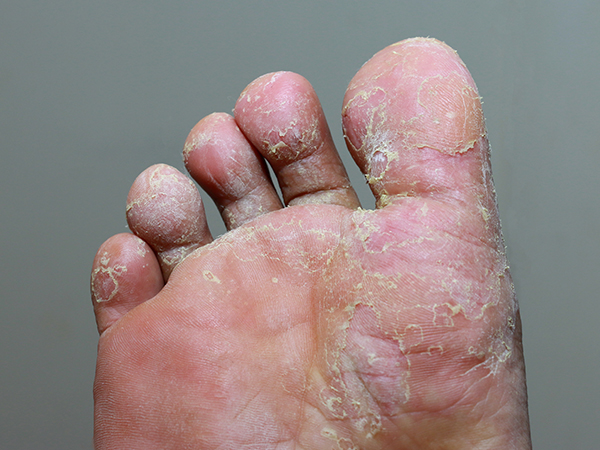Athlete’s foot, also known as tinea pedis, is a common fungal infection that affects the skin of the feet, particularly between the toes. It is highly contagious and can cause discomfort and itching. Here’s an overview of the causes, symptoms, and treatment options for athlete’s foot:
Causes:
Athlete’s foot is primarily caused by a group of fungi known as dermatophytes, which thrive in warm, moist environments. The fungus is often found in places like locker rooms, public showers, swimming pools, and gym floors. You can contract the infection by coming into direct contact with contaminated surfaces or by sharing personal items like shoes, socks, or towels with an infected person.
Symptoms:
The symptoms of athlete’s foot can vary in severity, and they may include:
- Itching: The most common symptom is intense itching, especially between the toes.
- Redness: The affected skin may become red and inflamed.
- Blisters: Small, fluid-filled blisters can develop on the skin.
- Cracking: The skin may become dry, scaly, and prone to cracking, which can be painful.
- Peeling: The skin may peel, particularly on the soles and sides of the feet.
- Burning Sensation: Some individuals may experience a burning or stinging sensation.
- Foul Odor: Athlete’s foot can sometimes lead to a foul odor.
Treatment:
- Over-the-Counter (OTC) Antifungal Medications: Many cases of athlete’s foot can be effectively treated with OTC antifungal creams, powders, or sprays. Look for products containing active ingredients like terbinafine, clotrimazole, or miconazole. Follow the product’s instructions for application. For recommendations, you can consult a dermatologist like Dr. Sana Younas.
- Keep Feet Clean and Dry: Proper foot hygiene is crucial. Wash your feet daily with soap and water, and make sure to thoroughly dry them, especially between the toes, to prevent the fungus from thriving in a moist environment.
- Wear Appropriate Footwear: Choose shoes made from breathable materials, like leather or canvas, and avoid tight-fitting shoes. Make sure to change your socks daily, and opt for moisture-wicking, breathable socks.
- Use Foot Powder: Applying antifungal foot powder can help keep your feet dry and reduce the risk of reinfection.
- Avoid Walking Barefoot in Public Areas: To prevent the spread of the infection, avoid walking barefoot in public places, especially in locker rooms and communal showers.
- Isolate Infected Items: If you have athlete’s foot, do not share shoes, socks, or towels with others, and wash your infected socks and towels separately in hot water.
- Prescription Medications: In cases of severe or persistent athlete’s foot, a healthcare provider may prescribe stronger antifungal medications, either topical or oral.
- Preventive Measures: Even after the infection has cleared, continue practicing good foot hygiene and preventive measures to avoid reinfection.
If you experience athlete’s foot symptoms that don’t improve with OTC treatments or if your condition worsens, consult a healthcare provider or a dermatologist. They can provide a proper diagnosis and recommend the most suitable treatment to eliminate the infection and prevent it from recurring.
You may also like
-
STD Clinic Dubai: Confidential & Professional STD Testing
-
Buy Shilajit UK Guide to Finding Authentic Himalayan Shilajit
-
Buy Shilajit Online: A Modern Path to Ancient Wellness
-
The Best Shilajit Brands: A Complete Guide to Quality, Purity & Performance
-
Unlocking Nature’s Secret: The Best Place to Buy Shilajit

